A Robust FISH Assay to Detect FGFR2 Translocations in Intrahepatic Cholangiocarcinoma Patients
Abstract
1. Introduction
2. Methods and Materials
2.1. Samples
2.2. FISH Hybridization
2.3. FISH Scoring
2.4. Probe Localization
2.5. Probe Sensitivity and Specificity
2.6. Database, Reference Range
2.7. NGS
3. Results
3.1. FISH Method Optimization
3.2. Probe Localization, Probe Sensitivity, and Specificity
3.3. Database, Reference Range
3.4. FGFR2 Translocation Detection in Twenty-Five (25) iCCA Patients
3.4.1. FISH Results
3.4.2. NGS Results
3.5. FGFR2::SHROOM3 Translocation
4. Discussion
4.1. Section Thickness
4.2. Break-Apart Signal Definitions and Its Diverse Signal Patterns
4.3. Comparison between Break-Apart FISH and NGS
4.4. FGFR2::SHROOM3 Translocation
5. Conclusions
Author Contributions
Funding
Institutional Review Board Statement
Informed Consent Statement
Data Availability Statement
Acknowledgments
Conflicts of Interest
References
- Bath, N.M.; Pawlik, T.M. Narrative Review: Current Management and Novel Targeted Therapies in Intrahepatic Cholangiocarcinoma. Chin. Clin. Oncol. 2023, 12, 5. [Google Scholar] [CrossRef] [PubMed]
- Proskuriakova, E.; Khedr, A. Current Targeted Therapy Options in the Treatment of Cholangiocarcinoma: A Literature Review. Cureus 2022, 14, e26233. [Google Scholar] [CrossRef] [PubMed]
- Mazzaferro, V.; El-Rayes, B.F.; Droz dit Busset, M.; Cotsoglou, C.; Harris, W.P.; Damjanov, N.; Masi, G.; Rimassa, L.; Personeni, N.; Braiteh, F.; et al. Derazantinib (ARQ 087) in Advanced or Inoperable FGFR2 Gene Fusion-Positive Intrahepatic Cholangiocarcinoma. Br. J. Cancer 2019, 120, 165–171. [Google Scholar] [CrossRef]
- Sootome, H.; Fujita, H.; Ito, K.; Ochiiwa, H.; Fujioka, Y.; Ito, K.; Miura, A.; Sagara, T.; Ito, S.; Ohsawa, H.; et al. Futibatinib Is a Novel Irreversible FGFR 1-4 Inhibitor That Shows Selective Antitumor Activity against FGFR-Deregulated Tumors. Cancer Res. 2020, 80, 4986–4997. [Google Scholar] [CrossRef]
- Liu, P.C.; Koblish, H.; Wu, L.; Bowman, K.; Diamond, S.; DiMatteo, D.; Zhang, Y.; Hansbury, M.; Rupar, M.; Wen, X.; et al. INCB054828 (Pemigatinib), a Potent and Selective Inhibitor of Fibroblast Growth Factor Receptors 1, 2, and 3, Displays Activity against Genetically Defined Tumor Models. PLoS ONE 2020, 15, e0231877. [Google Scholar] [CrossRef]
- Hoy, S.M. Pemigatinib: First Approval. Drugs 2020, 80, 923–929. [Google Scholar] [CrossRef] [PubMed]
- Chakrabarti, S.; Finnes, H.D.; Mahipal, A. Fibroblast Growth Factor Receptor (FGFR) Inhibitors in Cholangiocarcinoma: Current Status, Insight on Resistance Mechanisms and Toxicity Management. Expert Opin. Drug Metab. Toxicol. 2022, 18, 85–98. [Google Scholar] [CrossRef]
- Silverman, I.M.; Hollebecque, A.; Friboulet, L.; Owens, S.; Newton, R.C.; Zhen, H.; Féliz, L.; Zecchetto, C.; Melisi, D.; Burn, T.C. Clinicogenomic Analysis of FGFR2-Rearranged Cholangiocarcinoma Identifies Correlates of Response and Mechanisms of Resistance to Pemigatinib. Cancer Discov. 2021, 11, 326–339. [Google Scholar] [CrossRef]
- Borad, M.J.; Gores, G.J.; Roberts, L.R. Fibroblast Growth Factor Receptor 2 Fusions as a Target for Treating Cholangiocarcinoma. Curr. Opin. Gastroenterol. 2015, 31, 264–268. [Google Scholar] [CrossRef]
- Maruki, Y.; Morizane, C.; Arai, Y.; Ikeda, M.; Ueno, M.; Ioka, T.; Naganuma, A.; Furukawa, M.; Mizuno, N.; Uwagawa, T.; et al. Molecular Detection and Clinicopathological Characteristics of Advanced/Recurrent Biliary Tract Carcinomas Harboring the FGFR2 Rearrangements: A Prospective Observational Study (PRELUDE Study). J. Gastroenterol. 2021, 56, 250–260. [Google Scholar] [CrossRef]
- Zhu, Z.; Dong, H.; Wu, J.; Dong, W.; Guo, X.; Yu, H.; Fang, J.; Gao, S.; Chen, X.; Lu, H.; et al. Targeted Genomic Profiling Revealed a Unique Clinical Phenotype in Intrahepatic Cholangiocarcinoma with Fibroblast Growth Factor Receptor Rearrangement. Transl. Oncol. 2021, 14, 101168. [Google Scholar] [CrossRef] [PubMed]
- Pu, X.; Ye, Q.; Cai, J.; Yang, X.; Fu, Y.; Fan, X.; Wu, H.; Chen, J.; Qiu, Y.; Yue, S. Typing FGFR2 Translocation Determines the Response to Targeted Therapy of Intrahepatic Cholangiocarcinomas. Cell Death Dis. 2021, 12, 716. [Google Scholar] [CrossRef] [PubMed]
- Cremer, T.; Cremer, M. Chromosome Territories. Cold Spring Harb. Perspect. Biol. 2010, 2, a003889. [Google Scholar] [CrossRef] [PubMed]
- Wang, M.J.; Chen, F.; Lau, J.T.Y.; Hu, Y.P. Hepatocyte Polyploidization and Its Association with Pathophysiological Processes. Cell Death Dis. 2017, 8, e2805. [Google Scholar] [CrossRef]
- Cremer, T.; Cremer, M.; Dietzel, S.; Müller, S.; Solovei, I.; Fakan, S. Chromosome Territories—A Functional Nuclear Landscape. Curr. Opin. Cell Biol. 2006, 18, 307–316. [Google Scholar] [CrossRef]
- Donne, R.; Saroul-Aïnama, M.; Cordier, P.; Celton-Morizur, S.; Desdouets, C. Polyploidy in Liver Development, Homeostasis and Disease. Nat. Rev. Gastroenterol. Hepatol. 2020, 17, 391–405. [Google Scholar] [CrossRef]
- Watanabe, T.; Tanaka, Y. Age-Related Alterations in the Size of Human Hepatocytes. A Study of Mononuclear and Binucleate Cells. Virchows Arch. B 1982, 39, 9–20. [Google Scholar] [CrossRef]
- Soda, M.; Choi, Y.L.; Enomoto, M.; Takada, S.; Yamashita, Y.; Ishikawa, S.; Fujiwara, S.I.; Watanabe, H.; Kurashina, K.; Hatanaka, H.; et al. Identification of the Transforming EML4-ALK Fusion Gene in Non-Small-Cell Lung Cancer. Nature 2007, 448, 561–566. [Google Scholar] [CrossRef]
- De Melo, V.; Vetter, M.; Mazzullo, H.; Howard, J.D.; Betts, D.R.; Nacheva, E.P.; Apperley, J.F.; Reid, A.G. A Simple FISH Assay for the Detection of 3q26 Rearrangements in Myeloid Malignancy. Leukemia 2008, 22, 434–437. [Google Scholar] [CrossRef]
- Tirado, C.A.; Shabsovich, D.; Kim, Y.; Traum, P.; Pullarkat, S.; Kallen, M.; Rao, N. A Case of B-Cell Acute Lymphoblastic Leukemia in a Child with Down Syndrome Bearing a t(2;12)(P12;P13) Involving ETV6 and Biallelic IGH@ Rearrangements. Biomark. Res. 2015, 3, 11. [Google Scholar] [CrossRef]
- Gao, X.; Sholl, L.M.; Nishino, M.; Heng, J.C.; Jänne, P.A.; Oxnard, G.R. Clinical Implications of Variant ALK FISH Rearrangement Patterns. J. Thorac. Oncol. 2015, 10, 1648–1652. [Google Scholar] [CrossRef] [PubMed]
- Bunting, S.F.; Nussenzweig, A. End-Joining, Translocations and Cancer. Nat. Rev. Cancer 2013, 13, 443. [Google Scholar] [CrossRef] [PubMed]
- Wu, Y.M.; Su, F.; Kalyana-Sundaram, S.; Khazanov, N.; Ateeq, B.; Cao, X.; Lonigro, R.J.; Vats, P.; Wang, R.; Lin, S.F.; et al. Identification of Targetable FGFR Gene Fusions in Diverse Cancers. Cancer Discov. 2013, 3, 636–647. [Google Scholar] [CrossRef] [PubMed]
- Parker, B.C.; Engels, M.; Annala, M.; Zhang, W. Emergence of FGFR Family Gene Fusions as Therapeutic Targets in a Wide Spectrum of Solid Tumours. J. Pathol. 2014, 232, 4–15. [Google Scholar] [CrossRef] [PubMed]
- Li, F.; Peiris, M.N.; Donoghue, D.J. Functions of FGFR2 Corrupted by Translocations in Intrahepatic Cholangiocarcinoma. Cytokine Growth Factor Rev. 2020, 52, 56–67. [Google Scholar] [CrossRef] [PubMed]
- Yin, L.; Han, Z.; Feng, M.; Wang, J.; Xie, Z.; Yu, W.; Fu, X.; Shen, N.; Wang, X.; Duan, A.; et al. Chimeric Transcripts Observed in Non-Canonical FGFR2 Fusions with Partner Genes’ Breakpoint Located in Intergenic Region in Intrahepatic Cholangiocarcinoma. Cancer Genet. 2022, 266–267, 39–43. [Google Scholar] [CrossRef]
- Zhang, Y.; McCord, R.P.; Ho, Y.J.; Lajoie, B.R.; Hildebrand, D.G.; Simon, A.C.; Becker, M.S.; Alt, F.W.; Dekker, J. Spatial Organization of the Mouse Genome and Its Role in Recurrent Chromosomal Translocations. Cell 2012, 148, 908–921. [Google Scholar] [CrossRef]
- Lin, C.; Yang, L.; Tanasa, B.; Hutt, K.; Ju, B.G.; Ohgi, K.; Zhang, J.; Rose, D.W.; Fu, X.D.; Glass, C.K.; et al. Nuclear Receptor-Induced Chromosomal Proximity and DNA Breaks Underlie Specific Translocations in Cancer. Cell 2009, 139, 1069–1083. [Google Scholar] [CrossRef]
- Stapleton, D.; Balan, I.; Pawson, T.; Sicheri, F. The Crystal Structure of an Eph Receptor SAM Domain Reveals a Mechanism for Modular Dimerization. Nat. Struct. Biol. 1999, 6, 44–49. [Google Scholar] [CrossRef]
- Gerlitz, G.; Darhin, E.; Giorgio, G.; Franco, B.; Reiner, O. Novel Functional Features of the LIS-H Domain: Role in Protein Dimerization, Half-Life and Cellular Localization. Cell Cycle 2005, 4, 1632–1640. [Google Scholar] [CrossRef]
- Rackham, O.J.L.; Madera, M.; Armstrong, C.T.; Vincent, T.L.; Woolfson, D.N.; Gough, J. The Evolution and Structure Prediction of Coiled Coils across All Genomes. J. Mol. Biol. 2010, 403, 480–493. [Google Scholar] [CrossRef] [PubMed]
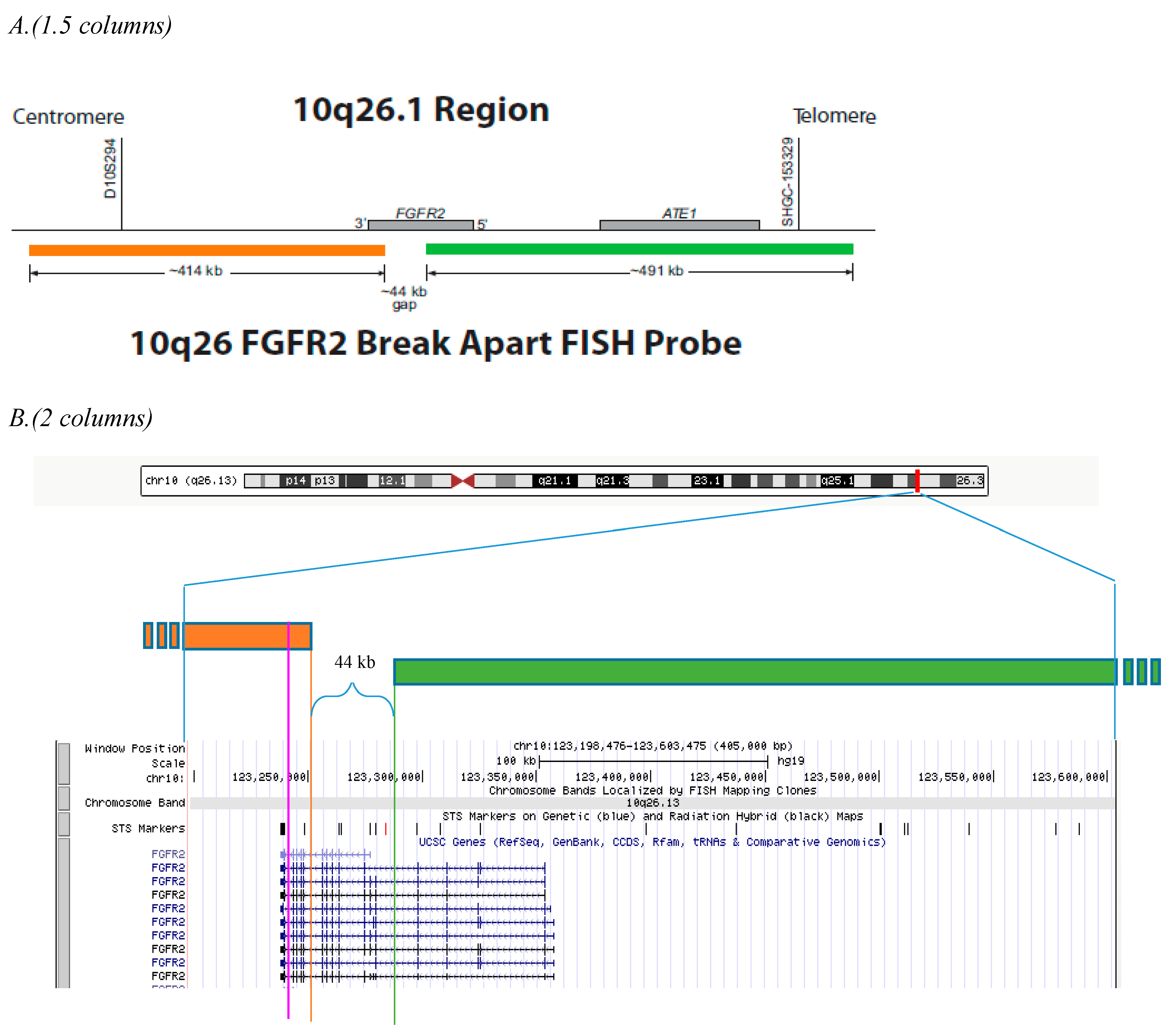
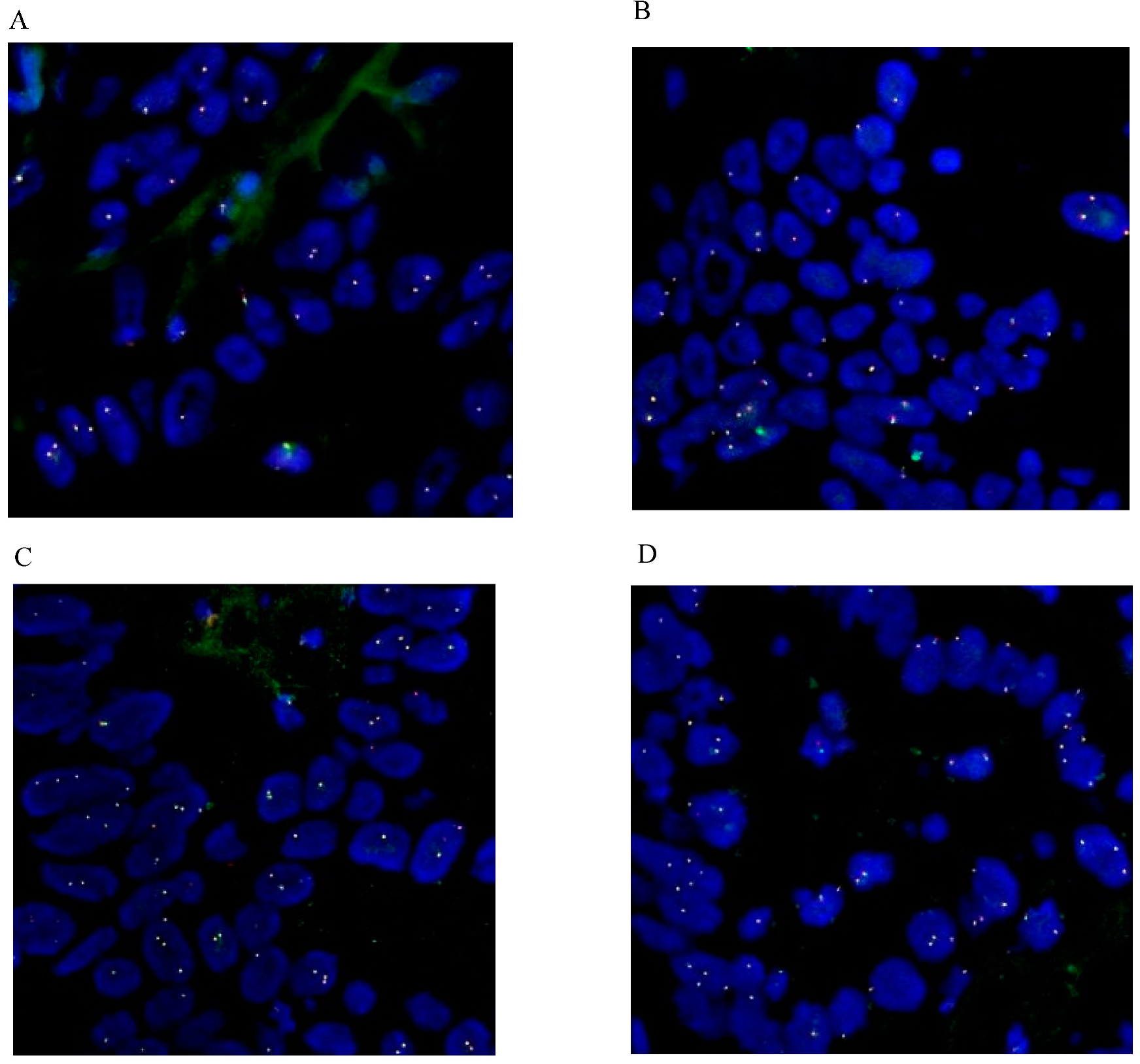
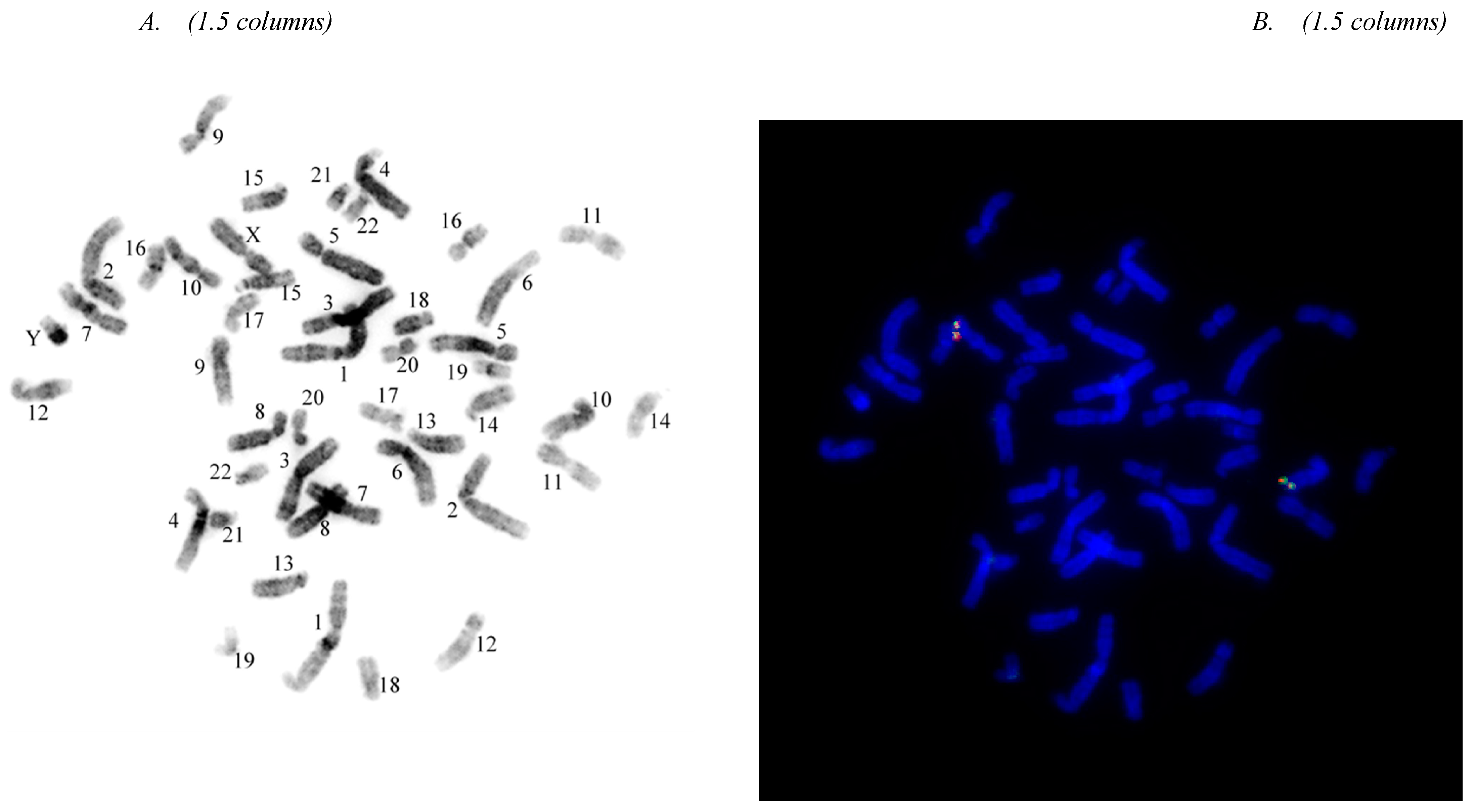
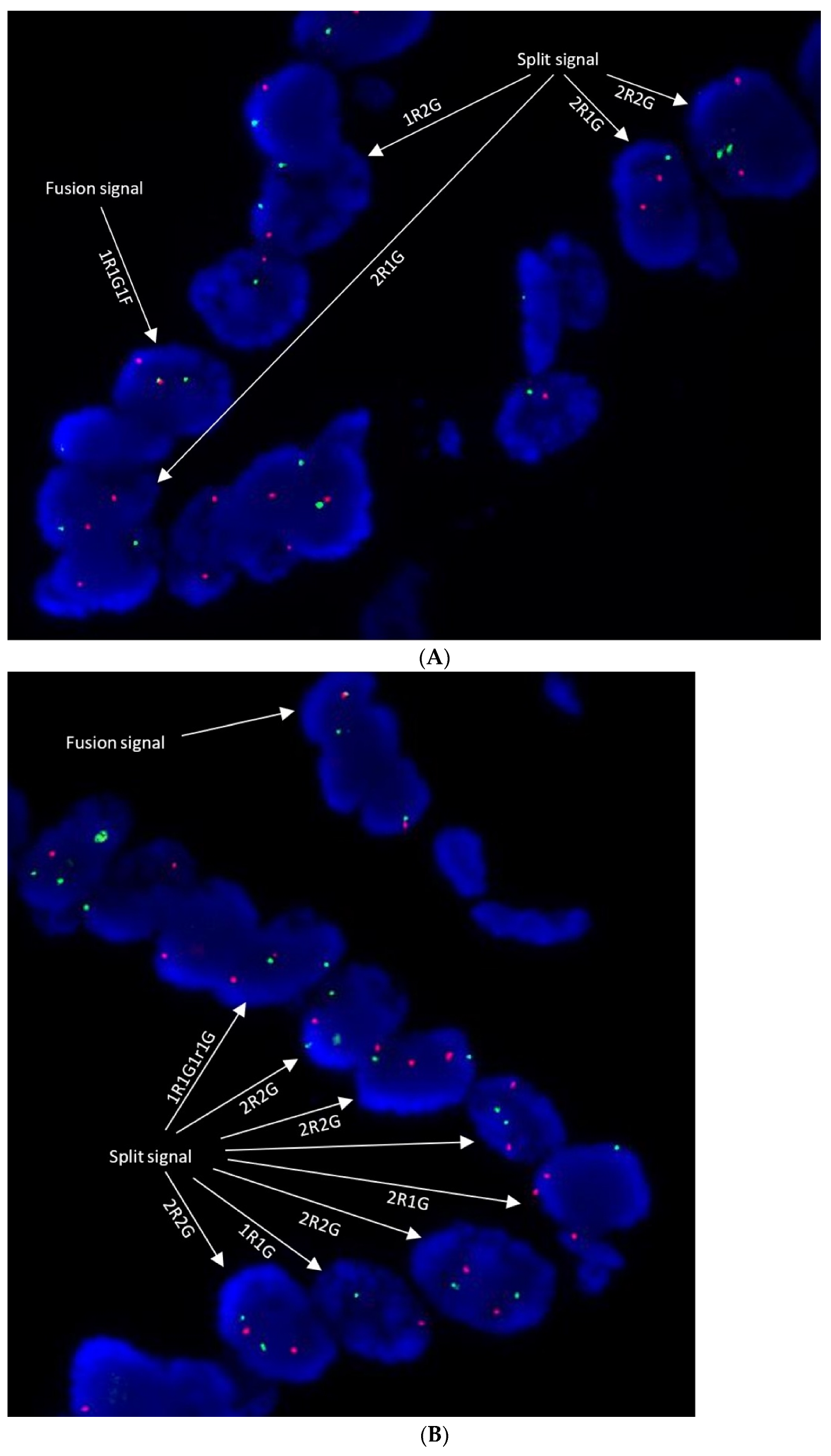
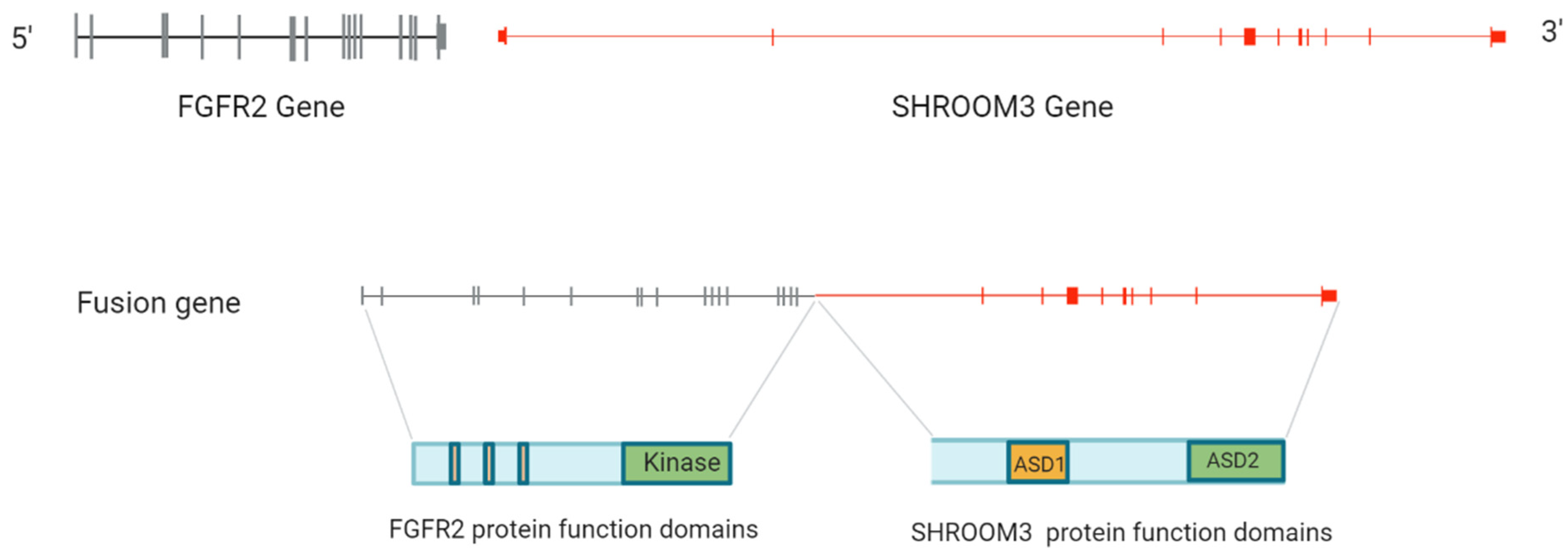

| Case No. | Age | Gender | Location | Histology Type | Stage | TNM_T | TNM_N | TNM_M |
|---|---|---|---|---|---|---|---|---|
| 1 | 73 | F | Liver | Cholangiocarcinoma | II | T2 | N1 | M0 |
| 2 | 38 | F | Liver | Cholangiocarcinoma | III | T2 | N0 | M0 |
| 3 | 51 | M | Liver | Cholangiocarcinoma | II | T2 | N1 | M0 |
| 4 | 42 | M | Liver | Cholangiocarcinoma | II | T2 | N1 | M0 |
| 5 | 53 | M | Liver | Cholangiocarcinoma | II | T2 | N0 | M0 |
| 6 | 64 | F | Liver | Cholangiocarcinoma | III | T2 | N0 | M0 |
| 7 | 63 | M | Liver | Cholangiocarcinoma | II | T2 | N0 | M0 |
| 8 | 64 | F | Liver | Cholangiocarcinoma | I | T2 | N0 | M0 |
| 9 | 26 | F | Liver | Cholangiocarcinoma | II | T2 | N0 | M0 |
| 10 | 66 | M | Liver | Cholangiocarcinoma | III | T2 | N0 | M0 |
| 11 | 58 | M | Liver | Cholangiocarcinoma | II | T2 | N0 | M0 |
| 12 | 60 | M | Liver | Cholangiocarcinoma | II | T3 | N1 | M0 |
| 13 | 72 | F | Liver | Cholangiocarcinoma | I | T3 | N1 | M0 |
| 14 | 56 | F | Liver | Cholangiocarcinoma | I~II | T2 | N1 | M0 |
| 15 | 47 | F | Liver | Cholangiocarcinoma | II | T2 | N0 | M0 |
| 16 | 47 | M | Liver | Cholangiocarcinoma | II | T2 | N0 | M0 |
| 17 | 70 | M | Liver | Cholangiocarcinoma | II | T2 | N0 | M0 |
| 18 | 47 | M | Liver | Cholangiocarcinoma | III | T2 | N0 | M0 |
| 19 | 29 | F | Liver | Cholangiocarcinoma | II | T2 | N0 | M0 |
| 20 | 57 | F | Liver | Cholangiocarcinoma | II | T2 | N1 | M0 |
| 21 | 66 | F | Liver | Cholangiocarcinoma | III | T2 | N1 | M0 |
| 22 | 64 | F | Liver | Cholangiocarcinoma | I | T1 | N0 | M0 |
| 23 | 51 | F | Liver | Cholangiocarcinoma | II~III | T2 | N0 | M0 |
| 24 | 61 | F | Liver | Cholangiocarcinoma | I~II | T1 | N0 | M0 |
| 25 | 33 | F | Liver | Cholangiocarcinoma | I | T2 | N1 | M0 |
| Configurations | Normal | Other Normal Signal Patterns | Break-Apart |
|---|---|---|---|
| Signal patterns | 2F | 1F | 1R1G1F |
| 100 target cells (400 targets) | 97 | 2 | 1 |
| Probe sensitivity | Probe specificity | ||
| 10q26.12-q26.13 (R) * | 98.5% (197/200) | 99.5% (197/198) | |
| 10q26.13 (G) ∥ | 98.5% (197/200) | 99.5% (197/198) | |
| Signal Patterns | BA * | 1F ∥ | 3F | 4F | 5F |
|---|---|---|---|---|---|
| Cutoffs (number of cells with the signal pattern in 100 cells enumerated) | 7 | 25 | 11 | 10 | 5 |
| Signal patterns | BA | 1F | 3F | 4F | 5F |
| Cutoffs (number of cells with the signal pattern in 50 cells enumerated) | 5 | 14 | 7 | 7 | 4 |
| Case No. | FISH | NGS |
|---|---|---|
| 10 | Negative | Indeterminate |
| 2 | Negative | Negative |
| 1 | Negative | Negative |
| 25 | Positive | Positive |
| 24 | Negative | Indeterminate |
| Tissue Type | 1F Ratio at 4 μm, % | 1F Ratio at 6 μm, % |
|---|---|---|
| Normal liver | 40.00 | 9.23 |
| Normal gallbladder | 40.40 | 18.03 |
| Hepatitis | 32.60 | 7.69 |
| Chronic cholecystitis | 38.80 | 15.09 |
| Chronic intrahepatic cholecystitis | 37.20 | 13.24 |
| Average | 37.80 | 12.66 |
| 5′ HEAD Genes | 3′ TAIL Partners | FGFR2 Partner Chromosomal Locations |
|---|---|---|
| FGFR2 | BICC1 | chr10 |
| KIAA1217 | chr10 | |
| AHCYL1 | chr1 | |
| CCDC6 | chr10 | |
| TACC2 | chr10 | |
| SHROOM3 | chr4 | |
| AFF4 | chr5 | |
| ARHGAP24 | chr4 | |
| CCDC170 | chr6 | |
| FILIP1 | chr6 | |
| MACF1 | chr1 | |
| NOL4 | chr18 | |
| NRAP | chr10 | |
| PAWR | chr12 | |
| SLMAP | chr3 | |
| TACC1 | chr8 | |
| TRIM8 | chr10 | |
| ACLY | chr17 | |
| ARHGAP22 | chr10 | |
| ATAD2 | chr8 | |
| ATF2 | chr2 | |
| BICD1 | chr12 | |
| CCDC158 | chr4 | |
| CDC42BPB | chr14 | |
| CEP128 | chr14 | |
| COL16A1 | chr1 | |
| CTNNA3 | chr10 | |
| DBP | chr19 | |
| DNAJC12 | chr10 | |
| EEA1 | chr12 | |
| EIF4ENIF1 (intergenic) | chr22 | |
| ERC1 | chr12 | |
| GAB2 | chr11 | |
| GOPC | chr6 | |
| INSC | chr11 | |
| KCTD1 | chr18 | |
| SHTN1/KIAA1598 | chr10 | |
| MATR3 | chr5 | |
| MCU | chr10 | |
| NEDD4L | chr18 | |
| NRBF2 | chr10 | |
| PAH | chr12 | |
| POC1B | chr12 | |
| PXN | chr12 | |
| RABGAP1L | chr1 | |
| RASSF4 | chr10 | |
| ROBO2 | chr3 | |
| RPAP3 | chr12 | |
| SFI1 | chr22 | |
| SOGA1 | chr20 | |
| SPICE1 | chr3 | |
| STRN4 | chr19 | |
| TBC1D1 | chr4 | |
| TCTN3 | chr10 | |
| TFEC | chr7 | |
| TTC28 | chr22 | |
| TXLNB | chr6 | |
| USH2A | chr1 | |
| VCL (intergenic) | chr10 | |
| WAC | chr10 | |
| WDHD1 | chr14 | |
| ZMYM4 | chr1 | |
| ZNF521 | chr18 | |
| MGEA5/OGA | chr10 | |
| TACC3 | chr4 | |
| CREB5 | chr7 | |
| CCDC186/C10orf118 | chr10 | |
| FRK | chr6 | |
| PPFIA2 | chr12 | |
| TLN1 | chr9 | |
| BAIAP2L1 (intergenic) | chr7 | |
| TNIP3 | chr4 | |
| LINC00863 | chr10 | |
| CBX5 (intergenic) | chr12 | |
| CFAP57 | chr1 | |
| PRDX3 | chr10 | |
| GOLGB1 | chr3 | |
| ETV6 | chr12 | |
| TFCP2L1 | chr2 | |
| TXLNA | chr1 | |
| RBFOX2 | chr22 | |
| BICC1 | FGFR2 | chr10 |
| VCL | chr10 | |
| CASC2 | chr10 | |
| WAC | chr10 | |
| ERICH2-DT | chr2 | |
| KIAA1217 | chr10 | |
| GOLGB1 | chr3 | |
| GMCL1 | chr2 | |
| SETD3 | chr14 |
Disclaimer/Publisher’s Note: The statements, opinions and data contained in all publications are solely those of the individual author(s) and contributor(s) and not of MDPI and/or the editor(s). MDPI and/or the editor(s) disclaim responsibility for any injury to people or property resulting from any ideas, methods, instructions or products referred to in the content. |
© 2023 by the authors. Licensee MDPI, Basel, Switzerland. This article is an open access article distributed under the terms and conditions of the Creative Commons Attribution (CC BY) license (https://creativecommons.org/licenses/by/4.0/).
Share and Cite
Zhang, L.; Zheng, H.; Xu, L.; You, S.; Shen, Y.; Han, Y.; Anderson, S. A Robust FISH Assay to Detect FGFR2 Translocations in Intrahepatic Cholangiocarcinoma Patients. Diagnostics 2023, 13, 2088. https://doi.org/10.3390/diagnostics13122088
Zhang L, Zheng H, Xu L, You S, Shen Y, Han Y, Anderson S. A Robust FISH Assay to Detect FGFR2 Translocations in Intrahepatic Cholangiocarcinoma Patients. Diagnostics. 2023; 13(12):2088. https://doi.org/10.3390/diagnostics13122088
Chicago/Turabian StyleZhang, Lei, Hao Zheng, Linyu Xu, Si You, Yuanyuan Shen, Yang Han, and Steve Anderson. 2023. "A Robust FISH Assay to Detect FGFR2 Translocations in Intrahepatic Cholangiocarcinoma Patients" Diagnostics 13, no. 12: 2088. https://doi.org/10.3390/diagnostics13122088
APA StyleZhang, L., Zheng, H., Xu, L., You, S., Shen, Y., Han, Y., & Anderson, S. (2023). A Robust FISH Assay to Detect FGFR2 Translocations in Intrahepatic Cholangiocarcinoma Patients. Diagnostics, 13(12), 2088. https://doi.org/10.3390/diagnostics13122088






